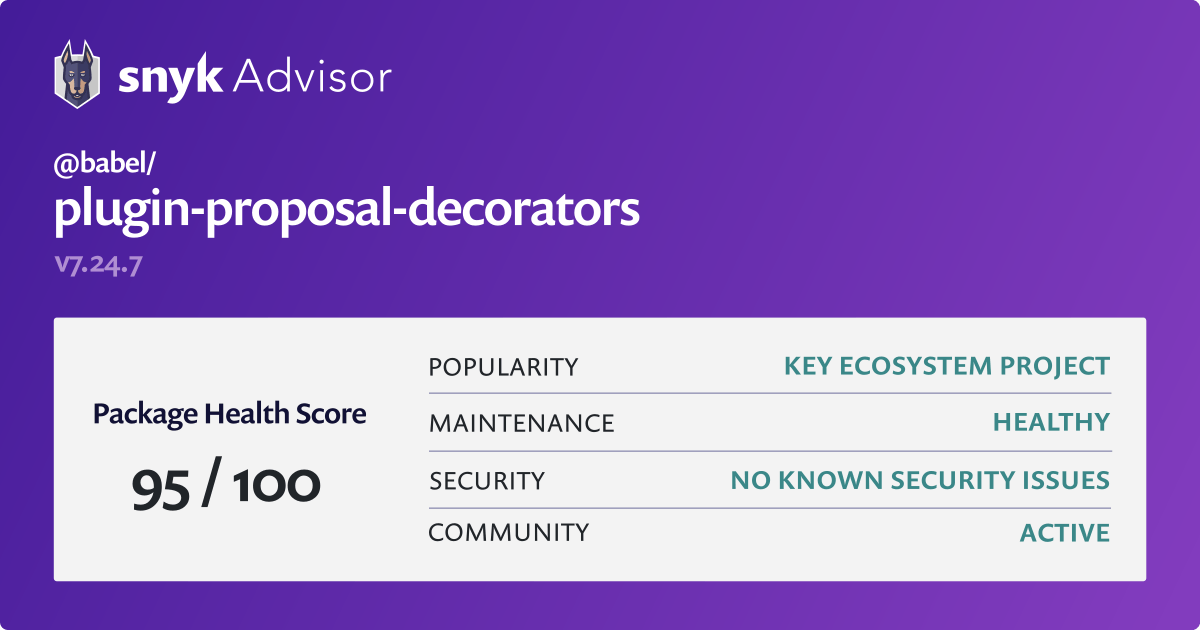Welcome to the world of JavaScript decorators! In this extensive article, we will dive into the Babel plugin proposal decorators. As an avid JavaScript developer, I can tell you that understanding decorators can unlock new potential in your code structure and readability. Whether you’re a seasoned developer or just starting, this guide is tailored for you.
What Are Decorators?
Before we delve into the Babel plugin, let’s clarify what decorators are. Decorators are a special kind of declaration that can be attached to a class or its members (methods, properties, etc.). They serve as an elegant way to modify the behavior of the target without modifying its code directly.
The Purpose of Babel Plugin Proposal Decorators
The Babel plugin for decorators allows developers to use decorators in their JavaScript code, even when the native JavaScript implementation isn’t available. This is especially valuable for those who want to adopt the decorator pattern without waiting for full support in browsers.
Getting Started with Babel Plugin Proposal Decorators
Installation
To utilize the Babel plugin for decorators, ensure you have Babel installed in your project. Here’s how you can set it up:

npm install --save-dev @babel/core @babel/preset-env babel-plugin-proposal-decoratorsConfiguring Babel
Next, you need to configure Babel to recognize the decorators. Add the following to your Babel configuration file (e.g., `.babelrc` or `babel.config.js`):

{
"presets": ["@babel/preset-env"],
"plugins": [
["@babel/plugin-proposal-decorators", { "legacy": true }]
]
}How to Use Decorators with Babel

Basic Syntax Example
Let’s look at a simple example of how decorators work in practice. Here’s a decorator that logs calls to a method:
function log(target, key, descriptor) {
const originalMethod = descriptor.value;
descriptor.value = function(...args) {
console.log(`Calling ${key} with`, args);
return originalMethod.apply(this, args);
};
return descriptor;
}
 class Example {
@log
showMessage(message) {
console.log(message);
}
}
const example = new Example();
example.showMessage('Hello, world!');
class Example {
@log
showMessage(message) {
console.log(message);
}
}
const example = new Example();
example.showMessage('Hello, world!');
Understanding the Components
In the example above:
- log: This is a decorator function that wraps the original method.
- @log: This syntax applies the decorator to the `showMessage` method.
- target: The prototype of the class.
- key: The name of the method being decorated.
- descriptor: The property descriptor for the method.
Practical Applications of Decorators

1. Logging and Monitoring
One of the most common uses of decorators is for logging function calls, which can be beneficial for debugging and monitoring purposes.
2. Access Control
Another significant use case is implementing role-based access control. For example:
function authorize(role) {
return function(target, key, descriptor) {
const originalMethod = descriptor.value;
descriptor.value = function(...args) {
if (this.role === role) {
return originalMethod.apply(this, args);
} else {
throw new Error('Unauthorized');
}
};
return descriptor;
};
}
class User {
constructor(role) {
this.role = role;
}
@authorize('admin')
deleteUser() {
console.log('User deleted');
}
}
const admin = new User('admin');
admin.deleteUser(); // Logs: 'User deleted'
const guest = new User('guest');
guest.deleteUser(); // Throws error: 'Unauthorized'Advantages of Using Babel Plugin Proposal Decorators
Increased Code Readability
Decorators can significantly improve the readability of your code, making it more intuitive and easier to understand at a glance.
Separation of Concerns
By using decorators, you can separate the logic of your methods from ancillary concerns like logging and access control, leading to cleaner code.
Reusable Logic
Decorators allow you to reuse the same logic across multiple methods or classes without repeating code.
Limitations and Considerations
1. Performance Overhead
While decorators provide many advantages, they can introduce slightly more performance overhead, as they wrap functions and classes. Nonetheless, this is often negligible in most applications.
2. Compatibility Issues
Since decorators are still a proposal in JavaScript, you may encounter compatibility issues when working in environments that do not support them natively.
Common FAQs About Babel Plugin Proposal Decorators
What are the main differences between decorators in TypeScript and Babel’s implementation?
TypeScript has its implementation of decorators, which is a bit more mature than Babel’s. While both concepts are similar, TypeScript’s decorators are part of the language itself, while Babel’s are introduced through plugins. This means TypeScript decorators might have additional features and stricter type checks.
Can I use decorators with functional components in React?
Decorators are primarily designed for class components. However, you can achieve similar functionality in functional components using higher-order components (HOCs) or custom hooks.
How do decorators affect TypeScript’s type inference?
In TypeScript, decorators can slightly affect type inference, as they introduce changes in the method signatures. TypeScript compiles the decorators before applying them, which can sometimes lead to type mismatches if not handled correctly.
Are decorators a standard feature in JavaScript?
As of now, decorators are still in the proposal stage in the TC39 committee. While many toolchains like Babel support them, you should keep an eye on their standardization status for long-term projects.
Conclusion
In conclusion, the Babel plugin proposal decorators open up a world of possibilities for JavaScript developers, making it easier to implement clean and maintainable code. While there are some limitations and performance considerations, the benefits often outweigh the downsides, especially when you adopt decorators thoughtfully in your projects.
As someone who has implemented decorators in various applications, I can assure you that once you grasp the concept, you’ll find yourself using them frequently to enhance your code quality and performance.
Thanks for reading! Feel free to share your thoughts or experiences with decorators in the comments below.
